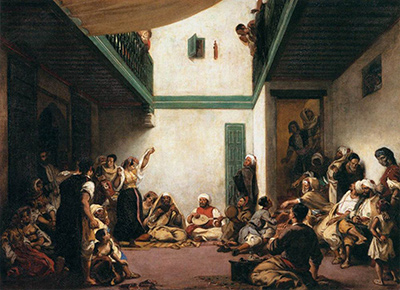The Jewish Wedding in Morocco by Eugene Delacroix was based on his memories, details that are written down in some of his books in Morocco.
The Jews and the Moors are at the entry. There are two musicians. The violinist has a thumb in the air, the lower part of the other hand is shaded.
The violinist is also seated on the galabia. The guitar's body lies on the knee of the player while his white sleeves tend to shadow behind.
The sleeves of his shirt turned back up extending to the bi-ceps while the green paneling tend to lie beside him. Just beside the violin there is a pretty Jewish woman; gold, sleeves, aramanthine and vest.
The Jewish woman is silhouetted in one way against the door, and another against the wall. Near, there is a woman with a great deal that almost wholly obscures her.
There is shadows with full of reflections and white colour appears on the shadows.
A pillar seems to emanate darkly on in front. The women to the left are carefully positioned as flower pots. Gold and white appears to be the core colours together with the yellow handkerchiefs.
Delacroix has also placed a child in front on the ground. Just beside the guitarist, there is a Jew who plays a tambourine.
The face of the Jew is a dark silhouette which hides part of the guitarist's hand.
The bottom of the head is clearly outlined against the wall.
There is also a little bit of gelabia located under the guitarist. Just in front of him, there is a young Jew holding a plate, and leaning on his shoulder there is a young Jewish child who is around ten years of age.
With this painting, Delacroix has followed his notes to the letter, and has modified some details such as the foreground pillar which otherwise would have an unbalanced composition, the painter as removed it as the child leans on the Jew with the plate.
The aged man who is seen from the back seen from the foreground does not play the tambourine.




